Financial Accounting Assignment: Goodwill, Intangible Assets, and WIP
VerifiedAdded on 2020/03/13
|7
|1385
|64
Homework Assignment
AI Summary
This financial accounting assignment solution addresses key concepts in financial reporting, including the recognition and measurement of goodwill, research and development expenditure, and production quotas. It analyzes the treatment of internally generated versus purchased goodwill, ad...
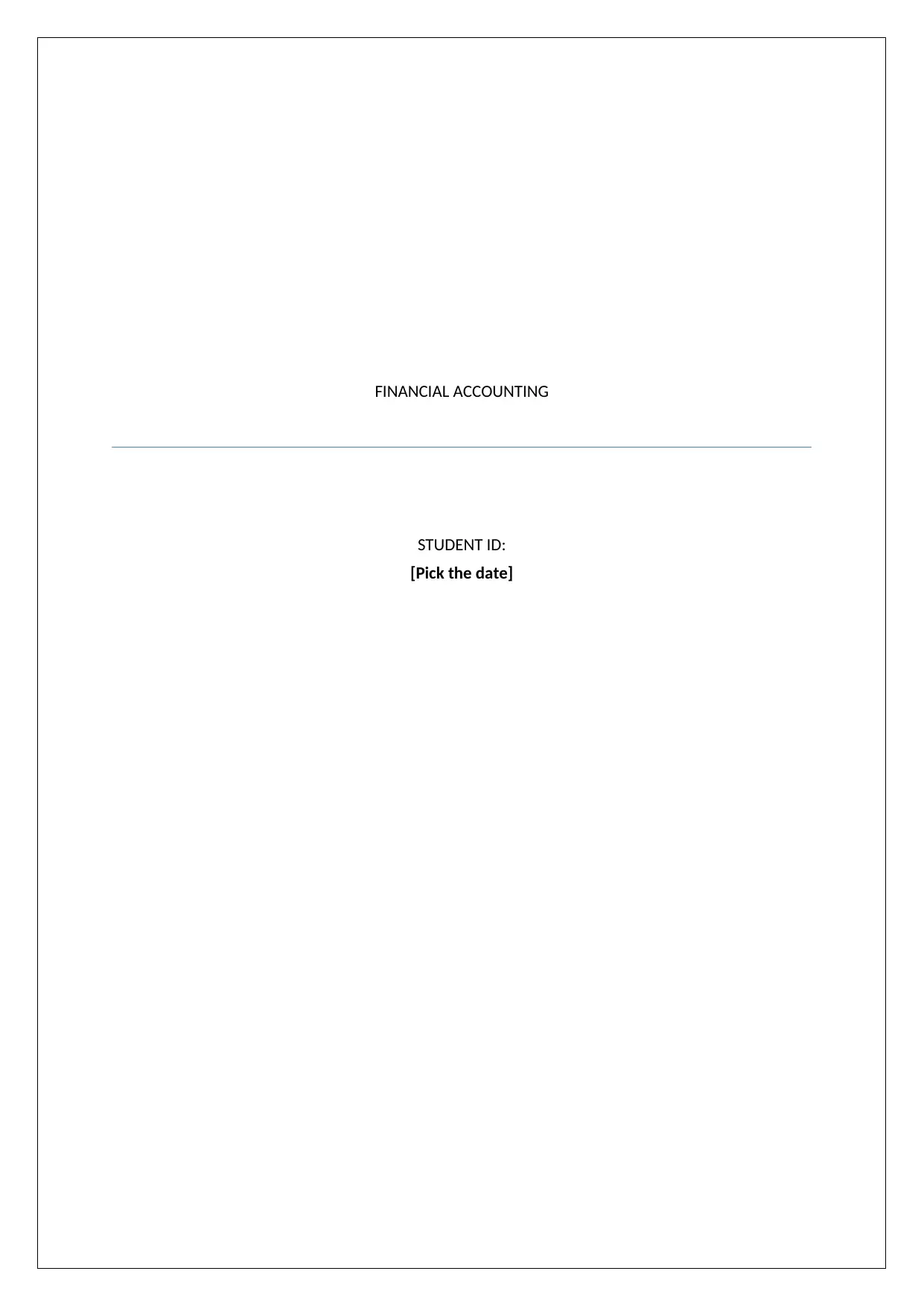
FINANCIAL ACCOUNTING
STUDENT ID:
[Pick the date]
STUDENT ID:
[Pick the date]
Paraphrase This Document
Need a fresh take? Get an instant paraphrase of this document with our AI Paraphraser

Financial Accounting
Question 1
a) Based on the given facts, it is apparent that no new business has been acquired by
Hillary and hence the goodwill which is being recognised has been internally
generated. However, in accordance with para 48 AASB 138, internally generated
goodwill cannot be represented (recognised) as an asset in the books of account
(AASB, 2015a).
b) Based on the given facts, it is apparent that Starlite Pty Ltd has purchased Syklite on
July 1, 2016 and out of the purchase price, $ 5,000 is on account of goodwill. Hence,
in accordance with para 33 AASB 138, the $ 5,000 paid for goodwill in the business
combination can be recognised as the goodwill on Starlite’s balance sheet as on July
1, 2016 (AASB, 2015a).
c) For FY2017, the company i.e. Starlite cannot recognise any amortization expense on
account of the available goodwill being purchased or internally generated. This is in
line with para 107 AASB 138 according to which an intangible asset having indefinite
life (such as goodwill) would not face any amortization. However, as per para 108,
such assets would have to undergo annual impairment test or whenever there is
impairment indication to determine if the carrying value of goodwill differs from the
fair value (AASB, 2015a).
d) In accordance with para 75 AASB 138, revaluation of intangible asset is possible if
there is an active market which can be determine the fair value. However, in the given
case, no active market would exist for goodwill and hence no revaluation would be
carried out (AASB, 2015a).
Question 2
a) It is apparent that there is development of software by the company which may be
recognised as expenses related to either research or development. As a result, the
relevant paragraphs would be para 8 (R&D definition), para 57(Capitalisation of R&D
expenditure) and para 54 (Research expenditure to be treated as expense) (AASB,
2015a).
b) The requisite table is indicated below.
Question 1
a) Based on the given facts, it is apparent that no new business has been acquired by
Hillary and hence the goodwill which is being recognised has been internally
generated. However, in accordance with para 48 AASB 138, internally generated
goodwill cannot be represented (recognised) as an asset in the books of account
(AASB, 2015a).
b) Based on the given facts, it is apparent that Starlite Pty Ltd has purchased Syklite on
July 1, 2016 and out of the purchase price, $ 5,000 is on account of goodwill. Hence,
in accordance with para 33 AASB 138, the $ 5,000 paid for goodwill in the business
combination can be recognised as the goodwill on Starlite’s balance sheet as on July
1, 2016 (AASB, 2015a).
c) For FY2017, the company i.e. Starlite cannot recognise any amortization expense on
account of the available goodwill being purchased or internally generated. This is in
line with para 107 AASB 138 according to which an intangible asset having indefinite
life (such as goodwill) would not face any amortization. However, as per para 108,
such assets would have to undergo annual impairment test or whenever there is
impairment indication to determine if the carrying value of goodwill differs from the
fair value (AASB, 2015a).
d) In accordance with para 75 AASB 138, revaluation of intangible asset is possible if
there is an active market which can be determine the fair value. However, in the given
case, no active market would exist for goodwill and hence no revaluation would be
carried out (AASB, 2015a).
Question 2
a) It is apparent that there is development of software by the company which may be
recognised as expenses related to either research or development. As a result, the
relevant paragraphs would be para 8 (R&D definition), para 57(Capitalisation of R&D
expenditure) and para 54 (Research expenditure to be treated as expense) (AASB,
2015a).
b) The requisite table is indicated below.
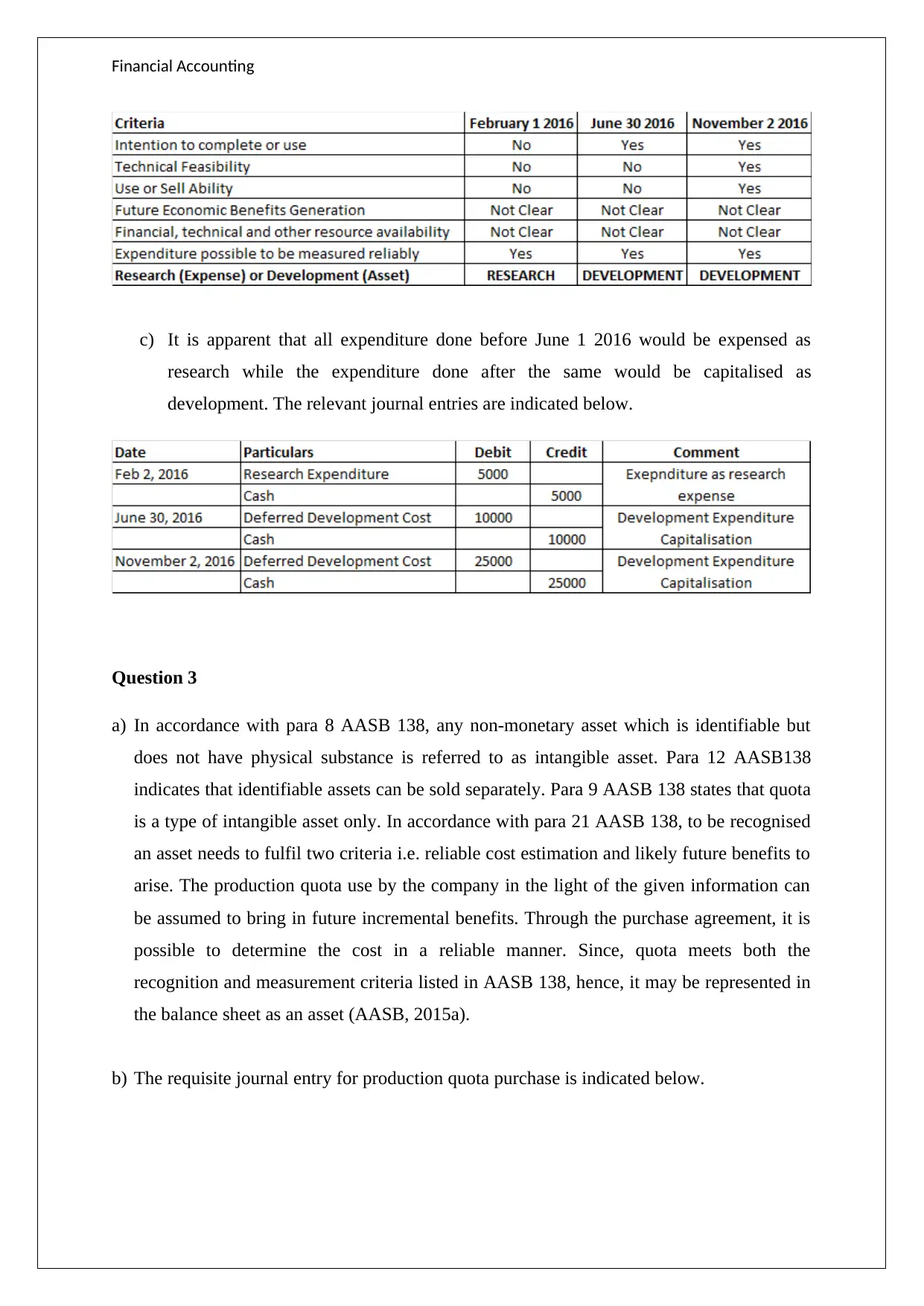
Financial Accounting
c) It is apparent that all expenditure done before June 1 2016 would be expensed as
research while the expenditure done after the same would be capitalised as
development. The relevant journal entries are indicated below.
Question 3
a) In accordance with para 8 AASB 138, any non-monetary asset which is identifiable but
does not have physical substance is referred to as intangible asset. Para 12 AASB138
indicates that identifiable assets can be sold separately. Para 9 AASB 138 states that quota
is a type of intangible asset only. In accordance with para 21 AASB 138, to be recognised
an asset needs to fulfil two criteria i.e. reliable cost estimation and likely future benefits to
arise. The production quota use by the company in the light of the given information can
be assumed to bring in future incremental benefits. Through the purchase agreement, it is
possible to determine the cost in a reliable manner. Since, quota meets both the
recognition and measurement criteria listed in AASB 138, hence, it may be represented in
the balance sheet as an asset (AASB, 2015a).
b) The requisite journal entry for production quota purchase is indicated below.
c) It is apparent that all expenditure done before June 1 2016 would be expensed as
research while the expenditure done after the same would be capitalised as
development. The relevant journal entries are indicated below.
Question 3
a) In accordance with para 8 AASB 138, any non-monetary asset which is identifiable but
does not have physical substance is referred to as intangible asset. Para 12 AASB138
indicates that identifiable assets can be sold separately. Para 9 AASB 138 states that quota
is a type of intangible asset only. In accordance with para 21 AASB 138, to be recognised
an asset needs to fulfil two criteria i.e. reliable cost estimation and likely future benefits to
arise. The production quota use by the company in the light of the given information can
be assumed to bring in future incremental benefits. Through the purchase agreement, it is
possible to determine the cost in a reliable manner. Since, quota meets both the
recognition and measurement criteria listed in AASB 138, hence, it may be represented in
the balance sheet as an asset (AASB, 2015a).
b) The requisite journal entry for production quota purchase is indicated below.
⊘ This is a preview!⊘
Do you want full access?
Subscribe today to unlock all pages.

Trusted by 1+ million students worldwide
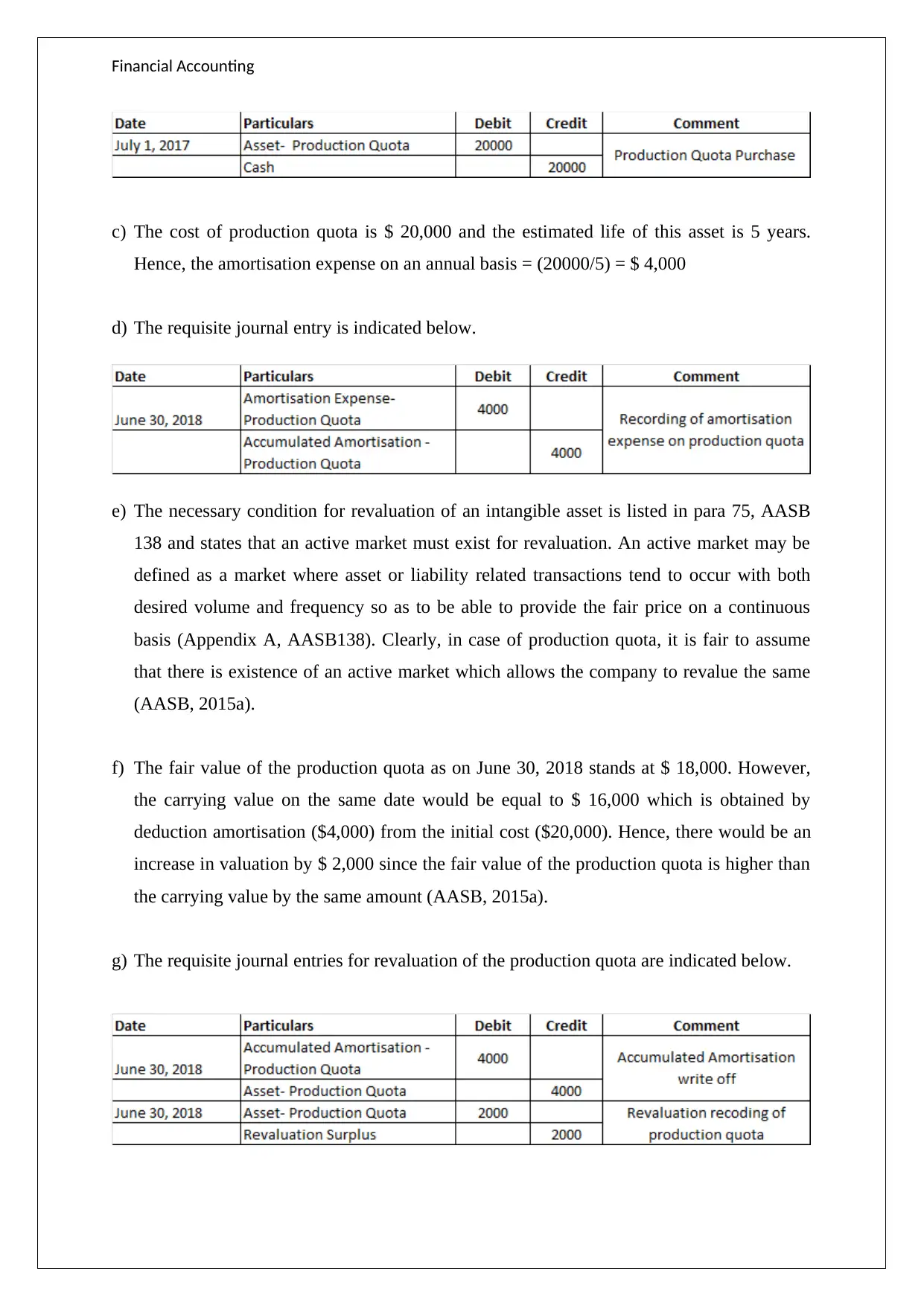
Financial Accounting
c) The cost of production quota is $ 20,000 and the estimated life of this asset is 5 years.
Hence, the amortisation expense on an annual basis = (20000/5) = $ 4,000
d) The requisite journal entry is indicated below.
e) The necessary condition for revaluation of an intangible asset is listed in para 75, AASB
138 and states that an active market must exist for revaluation. An active market may be
defined as a market where asset or liability related transactions tend to occur with both
desired volume and frequency so as to be able to provide the fair price on a continuous
basis (Appendix A, AASB138). Clearly, in case of production quota, it is fair to assume
that there is existence of an active market which allows the company to revalue the same
(AASB, 2015a).
f) The fair value of the production quota as on June 30, 2018 stands at $ 18,000. However,
the carrying value on the same date would be equal to $ 16,000 which is obtained by
deduction amortisation ($4,000) from the initial cost ($20,000). Hence, there would be an
increase in valuation by $ 2,000 since the fair value of the production quota is higher than
the carrying value by the same amount (AASB, 2015a).
g) The requisite journal entries for revaluation of the production quota are indicated below.
c) The cost of production quota is $ 20,000 and the estimated life of this asset is 5 years.
Hence, the amortisation expense on an annual basis = (20000/5) = $ 4,000
d) The requisite journal entry is indicated below.
e) The necessary condition for revaluation of an intangible asset is listed in para 75, AASB
138 and states that an active market must exist for revaluation. An active market may be
defined as a market where asset or liability related transactions tend to occur with both
desired volume and frequency so as to be able to provide the fair price on a continuous
basis (Appendix A, AASB138). Clearly, in case of production quota, it is fair to assume
that there is existence of an active market which allows the company to revalue the same
(AASB, 2015a).
f) The fair value of the production quota as on June 30, 2018 stands at $ 18,000. However,
the carrying value on the same date would be equal to $ 16,000 which is obtained by
deduction amortisation ($4,000) from the initial cost ($20,000). Hence, there would be an
increase in valuation by $ 2,000 since the fair value of the production quota is higher than
the carrying value by the same amount (AASB, 2015a).
g) The requisite journal entries for revaluation of the production quota are indicated below.
Paraphrase This Document
Need a fresh take? Get an instant paraphrase of this document with our AI Paraphraser
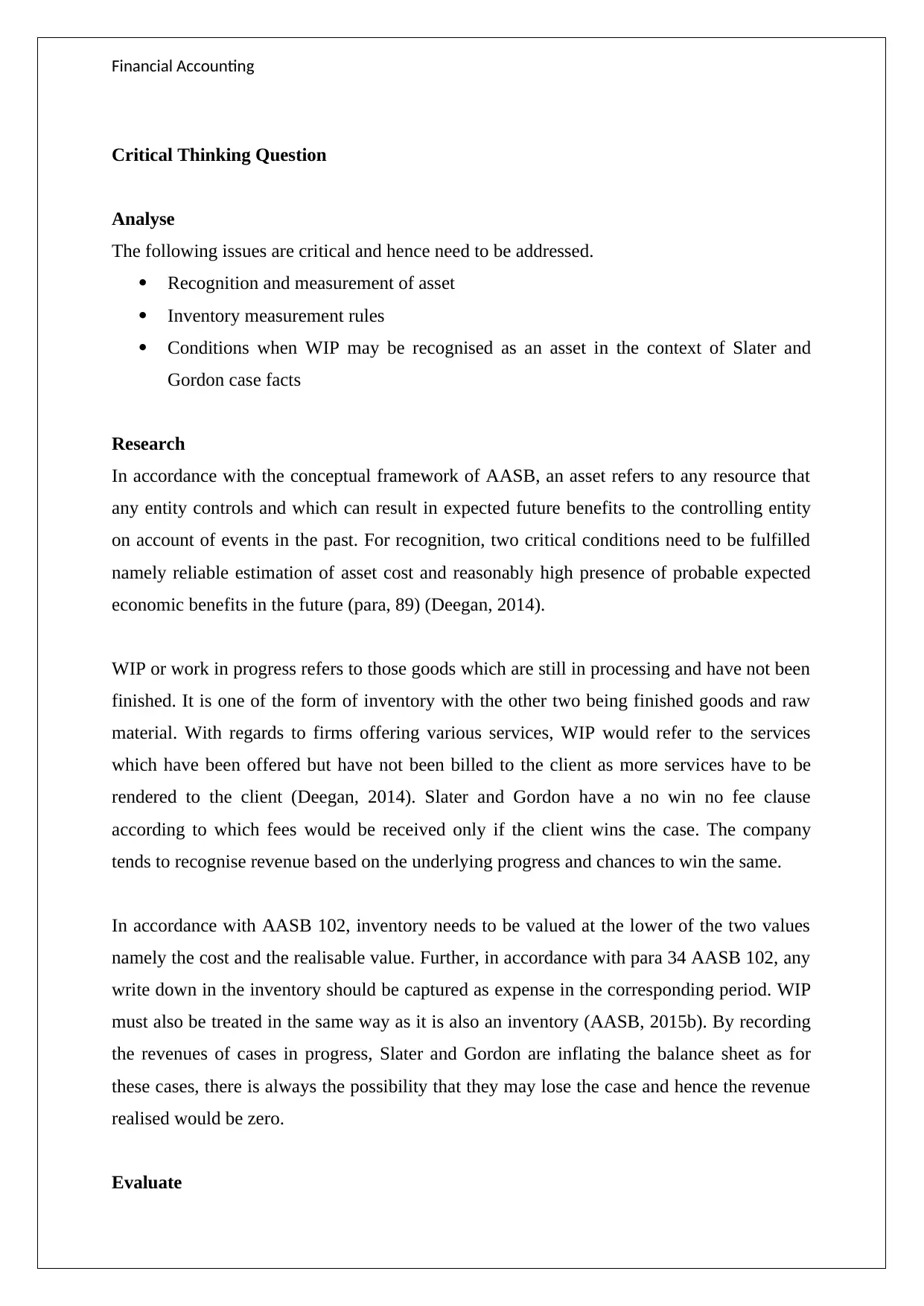
Financial Accounting
Critical Thinking Question
Analyse
The following issues are critical and hence need to be addressed.
Recognition and measurement of asset
Inventory measurement rules
Conditions when WIP may be recognised as an asset in the context of Slater and
Gordon case facts
Research
In accordance with the conceptual framework of AASB, an asset refers to any resource that
any entity controls and which can result in expected future benefits to the controlling entity
on account of events in the past. For recognition, two critical conditions need to be fulfilled
namely reliable estimation of asset cost and reasonably high presence of probable expected
economic benefits in the future (para, 89) (Deegan, 2014).
WIP or work in progress refers to those goods which are still in processing and have not been
finished. It is one of the form of inventory with the other two being finished goods and raw
material. With regards to firms offering various services, WIP would refer to the services
which have been offered but have not been billed to the client as more services have to be
rendered to the client (Deegan, 2014). Slater and Gordon have a no win no fee clause
according to which fees would be received only if the client wins the case. The company
tends to recognise revenue based on the underlying progress and chances to win the same.
In accordance with AASB 102, inventory needs to be valued at the lower of the two values
namely the cost and the realisable value. Further, in accordance with para 34 AASB 102, any
write down in the inventory should be captured as expense in the corresponding period. WIP
must also be treated in the same way as it is also an inventory (AASB, 2015b). By recording
the revenues of cases in progress, Slater and Gordon are inflating the balance sheet as for
these cases, there is always the possibility that they may lose the case and hence the revenue
realised would be zero.
Evaluate
Critical Thinking Question
Analyse
The following issues are critical and hence need to be addressed.
Recognition and measurement of asset
Inventory measurement rules
Conditions when WIP may be recognised as an asset in the context of Slater and
Gordon case facts
Research
In accordance with the conceptual framework of AASB, an asset refers to any resource that
any entity controls and which can result in expected future benefits to the controlling entity
on account of events in the past. For recognition, two critical conditions need to be fulfilled
namely reliable estimation of asset cost and reasonably high presence of probable expected
economic benefits in the future (para, 89) (Deegan, 2014).
WIP or work in progress refers to those goods which are still in processing and have not been
finished. It is one of the form of inventory with the other two being finished goods and raw
material. With regards to firms offering various services, WIP would refer to the services
which have been offered but have not been billed to the client as more services have to be
rendered to the client (Deegan, 2014). Slater and Gordon have a no win no fee clause
according to which fees would be received only if the client wins the case. The company
tends to recognise revenue based on the underlying progress and chances to win the same.
In accordance with AASB 102, inventory needs to be valued at the lower of the two values
namely the cost and the realisable value. Further, in accordance with para 34 AASB 102, any
write down in the inventory should be captured as expense in the corresponding period. WIP
must also be treated in the same way as it is also an inventory (AASB, 2015b). By recording
the revenues of cases in progress, Slater and Gordon are inflating the balance sheet as for
these cases, there is always the possibility that they may lose the case and hence the revenue
realised would be zero.
Evaluate

Financial Accounting
Based on the above analysis, it is apparent that the company must not realise the revenues till
the outcome is decided as the cash flows cannot be termed as probable considering the policy
of not charging any fees in the event of the case being lost. There is high uncertainty
associated in the given case. Also the recognition of the WIP in the balance sheet as per the
current policy is not acceptable as has been discussed because the lower realisable value can
potentially be zero and it would only become clear after the outcome of the same has been
decided.
Based on the above analysis, it is apparent that the company must not realise the revenues till
the outcome is decided as the cash flows cannot be termed as probable considering the policy
of not charging any fees in the event of the case being lost. There is high uncertainty
associated in the given case. Also the recognition of the WIP in the balance sheet as per the
current policy is not acceptable as has been discussed because the lower realisable value can
potentially be zero and it would only become clear after the outcome of the same has been
decided.
⊘ This is a preview!⊘
Do you want full access?
Subscribe today to unlock all pages.

Trusted by 1+ million students worldwide
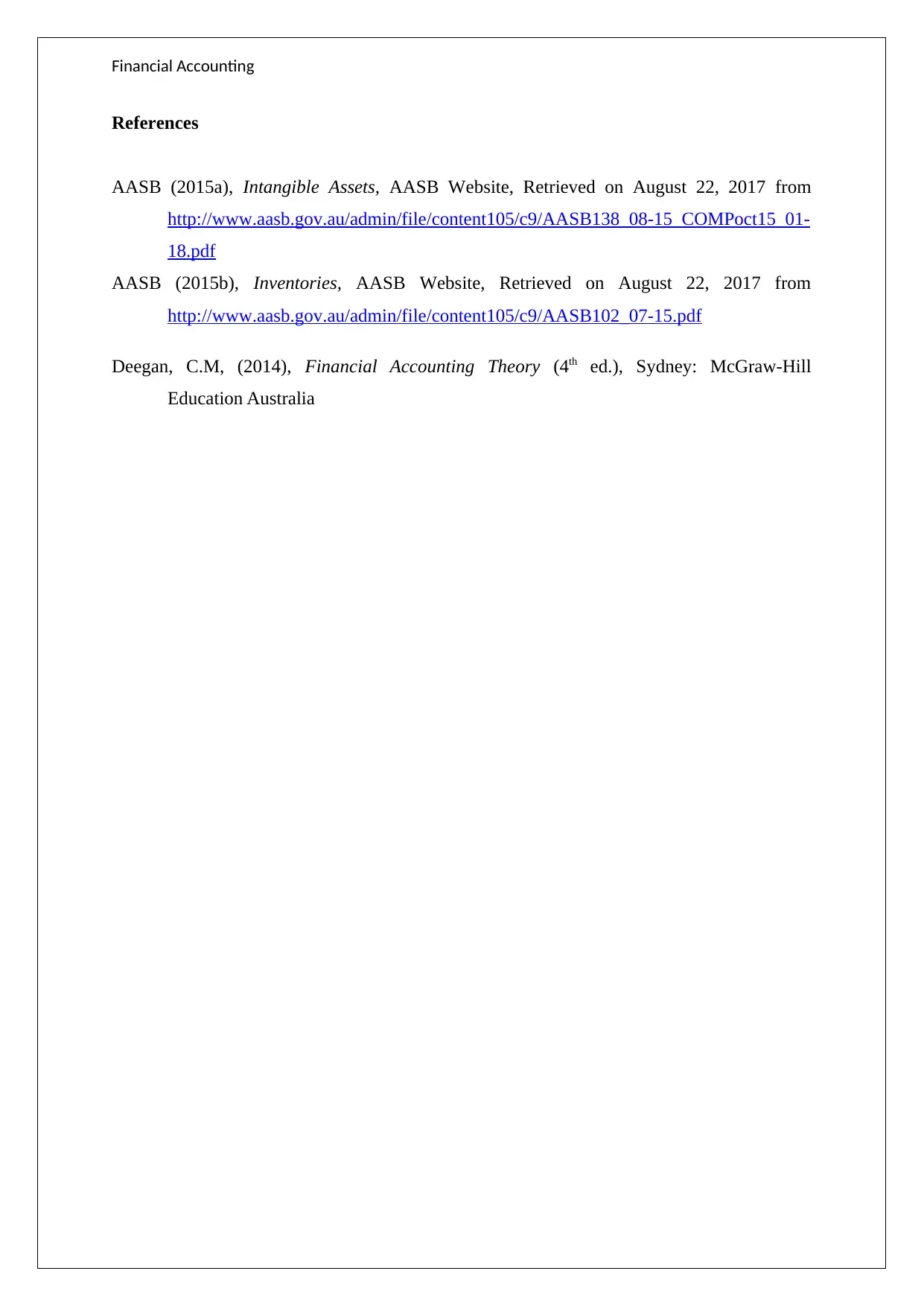
Financial Accounting
References
AASB (2015a), Intangible Assets, AASB Website, Retrieved on August 22, 2017 from
http://www.aasb.gov.au/admin/file/content105/c9/AASB138_08-15_COMPoct15_01-
18.pdf
AASB (2015b), Inventories, AASB Website, Retrieved on August 22, 2017 from
http://www.aasb.gov.au/admin/file/content105/c9/AASB102_07-15.pdf
Deegan, C.M, (2014), Financial Accounting Theory (4th ed.), Sydney: McGraw-Hill
Education Australia
References
AASB (2015a), Intangible Assets, AASB Website, Retrieved on August 22, 2017 from
http://www.aasb.gov.au/admin/file/content105/c9/AASB138_08-15_COMPoct15_01-
18.pdf
AASB (2015b), Inventories, AASB Website, Retrieved on August 22, 2017 from
http://www.aasb.gov.au/admin/file/content105/c9/AASB102_07-15.pdf
Deegan, C.M, (2014), Financial Accounting Theory (4th ed.), Sydney: McGraw-Hill
Education Australia
1 out of 7
Related Documents
Your All-in-One AI-Powered Toolkit for Academic Success.
+13062052269
info@desklib.com
Available 24*7 on WhatsApp / Email
![[object Object]](/_next/static/media/star-bottom.7253800d.svg)
Unlock your academic potential
© 2024 | Zucol Services PVT LTD | All rights reserved.




